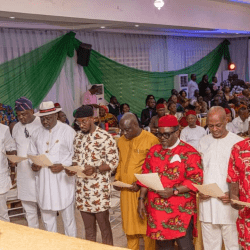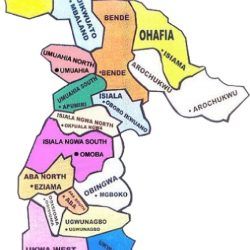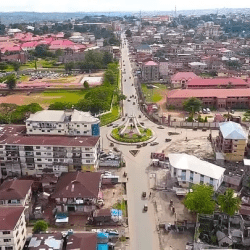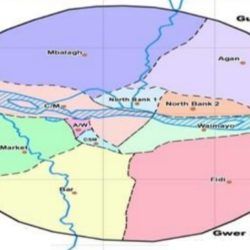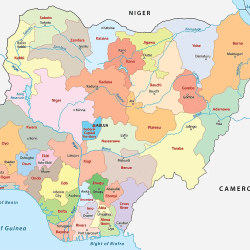Abia State consists of 267 Council Wards in 17 Local Government Areas (LGAs).
The 17 LGAs are:
- Aba North
- Aba South
- Arochukwu
- Bende
- Ikwuano
- Isiala-Ngwa North
- Isiala-Ngwa South
- Isuikwuato
- Obi Ngwa
- Ohafia
- Osisioma Ngwa
- Ugwunagbo
- Ukwa East
- Ukwa West
- Umuahia North
- Umuahia South
- Umu-Nneochi
The 267 Council Wards, located in the 17 LGAs, are:
(1) Abia North LGA
- Eziama
- Industrial Area
- Osusu I
- Osusu II
- St. Eugenes By Okigwe Rd
- Uratta
- Old Aba Gra
- Umuola
- Ariaria Market
- Ogbor I
- Ogbor II
- Umuogor
(2) Aba South
- Eziukwu
- Asa
- Enyiama
- Ngwa
- Ohazu I
- Ohazu II
- Igwebuike
- Ekeoha
- Glouchester
- Mosque
- Aba River
- Aba Town Hall
(3) Arochukwu
- Ovukwu
- Ohaeke
- Ohafor I
- Ohafor II
- Arochukwu I
- Arochukwu II
- Ikwun Ihechiowa
- Eleoha Ihechiowa
- Ututu
- Isu
- Arochukwu III
(4) Bende
- Aminkalu/Akoliufu
- Bende
- Ugwueke/Ezeukwu
- Igbere ‘A’
- Igbere ‘B’
- Item ‘A’
- Item ‘B’
- Item ‘C’
- Itumbauzo
- Ozuitem
- Umuhu/Ezechi
- Umu-Imenyi
- Uzuakoli
(5) Ikwuano
- Oloko I
- Oloko II
- Ibere I
- Ibere II
- Oboro I
- Oboro II
- Oboro III
- Oboro IV
- Ariam
- Usaka
(6) Isiala Ngwa North
- Amasaa Nsulu
- Umunna Nsulu
- Isiala Nsulu
- Ngwa Ukwu II
- Ngwa Ukwu I
- Ijie
- Amasaa Ntigha
- Amapu Ntigha
- Umuoha
- Mbawsi/Umuoma Inta
(7) Isiala Ngwa South
- Amaise/Amaise Aiyaba
- Ngwaobi
- Mbutu Ukwu
- Mbutu Ngwa
- Ehi Na Guru Osokwa
- Akunekpu Eziama
- Na Obuba
- Ovungwu
- Ovuokwu
- Okporo Ahaba
(8) Isuikwuato
- Imenyi
- Ezere
- Isiala-Amawu
- Isu-Amawu
- Oguduasa
- Umunnekwu
- Achara/Mbaugwu
- Ikeagha I
- Ikeagha II
- Umuanyi/Absu
(9) Obingwa
- Abayi I
- Abayi II
- Mgboko Umuanunu
- Mgboko Itun Gwa
- Ahiaba
- Mgboko Amairi
- Alaukwu Ohanze
- Akumaimo
- Ndiakata/Amairinabua
- Ntighauzo Amairi
- Ibeme
(10) Ohafia
- Isama Ohafia
- Ebem Ohafia
- Ndi Elu Nkporo
- Ndi Etiti Nkporo
- Amaeke Abiriba
- Amaogudu Abiriba
- Agboji Abiriba
- Ohafor Ohafia
- Okamu Ohafia
- Ania Ohafia
- Ndi Agbo Nkporo
(11) Osisioma
- Amavo
- Amaitolu-Mbutu Umuojima
- Amasator
- Aro-Ngwa
- Ama-Asaa
- Oso-Okwa
- Uratta
- Amator
- Umunneise
- Okpu-Umuobo
(12) Ugwunagbo
- Ward One
- Ward Two
- Ward Three
- Ward Four
- Ward Five
- Ward Six
- Ward Seven
- Ward Eight
- Ward Nine
- Ward Ten
(13) Ukwa East
- Ikwuriator East
- Ikuriator West
- Azumini
- Umuigube Achara
- Akwete
- Obohia
- Ikwueke East
- Ikwueke West
- Nkporobe/Ohuru
- Ikwuorie
(14) Ukwa West
- Asa North
- Obokwe
- Ogwe
- Asa South
- Obuzor
- Ipu West
- Ipu East
- Ipu South
- Ozaa Ukwu
- Ozaa West
(15) Umuahia North
- Ibeku East I
- Ibeku East II
- Ndume
- Ibeku West
- Umuahia Urban I
- Umuahia Urban II
- Umuahia Urban III
- Nkwoachara
- Nkwoegwu
- Afugiri
- Umuhu
- Isingwu
(16) Umuahia South
- Ezeleke/Ogbo Diukwu
- Omaegwu
- Ohiaocha
- Amiaukwu I
- Amiaukwu II
- Old Umuahia
- Amakama
- Ubakala ‘A’
- Nsirimo
- Ubakala ‘B’
(17) Umu-Nneochi
- Amuda
- Umuaku
- Mbala/Achara
- Ezin Godo
- Ndiawa/Umuelem/Ihie/Amorie
- Eziama-Ugwu
- Eziama-Agbo
- Ubahu/Akawa/Aroikpa
- Umuchieze I
- Umuchieze II
- Umuchieze III
- Obinolu/Obiagu/Lomara

Abia State is bordered by Anambra, Enugu, Ebonyi, Imo, Cross River, Akwa Ibom, and Rivers states, and it is the only Southeastern state that has boundary with all the other four Southeastern states in Nigeria.
While the head of LGA is chairman, councilor is the head of a council ward.
Each LGA is subdivided into council wards. Wards in Abia State play a critical role in local governance and serve as electoral units for both state and national elections. They ensure effective representation at the grassroots level, allowing for efficient management of public services and resources. Furthermore, the distribution of council wards within Local Government Areas ensures that local leaders can address the specific needs of their communities more effectively.
Each ward elects a councillor to represent its people in the local government council, thus enabling direct participation in governance by the electorate.
Abia State’s council wards structure facilitates grassroots governance and ensures that local administrations are tailored to the unique needs of smaller communities. By understanding the wards in each Local Government Area, residents can better engage with their local governance systems and participate in decision-making processes that affect their daily lives.
